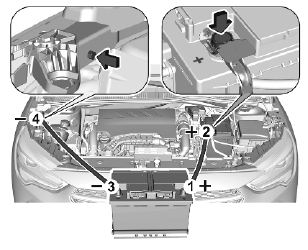Opel Corsa: Vehicle care / Jump starting
Opel Corsa 2020-2025 Owners Manual / Vehicle care / Jump starting
Do not start with quick charger.
A vehicle with a discharged vehicle battery can be started using jump leads and the vehicle battery of another vehicle.
Warning
Be extremely careful when starting with jump leads. Any deviation from the following instructions can lead to injuries or damage caused by battery explosion or damage to the electrical systems of both vehicles.
Warning
Avoid contact of the battery with eyes, skin, fabrics and painted surfaces. The fluid contains sulphuric acid which can cause injuries and damage in the event of direct contact.
- Never expose the vehicle battery to naked flames or sparks.
- A discharged vehicle battery can already freeze at a temperature of 0 °C. Defrost the frozen battery before connecting jump leads.
- Wear eye protection and protective clothing when handling a battery.
- Use a booster battery with the same voltage (12 V). Its capacity (Ah) must not be much less than that of the discharged vehicle battery.
- Use jump leads with insulated terminals and a cross section of at least 16 mm2 (25 mm2 for diesel engines).
- Do not disconnect the discharged vehicle battery from the vehicle.
- Switch off all unnecessary electrical consumers.
- Do not lean over the vehicle battery during jump starting.
- Do not allow the terminals of one lead to touch those of the other lead.
- The vehicles must not come into contact with each other during the jump starting process.
- Apply the parking brake, transmission in neutral, automatic transmission in P.

Lead connection order:
- Connect the red lead to the positive terminal of the booster battery.
- Connect the other end of the red lead to the positive terminal of the discharged battery.
- Connect the black lead to the negative terminal of the booster battery.
- Connect the other end of the black lead to a vehicle grounding point of your vehicle in the engine compartment.
Route the leads so that they cannot catch on rotating parts in the engine compartment.
To start the engine:
- Start the engine of the vehicle providing the jump.
- After 5 minutes, start the other engine. Start attempts should be made for no longer than 15 seconds at an interval of 1 minute.
- Allow both engines to idle for approx. 3 minutes with the leads connected.
- Switch on the needed electrical consumers e.g. headlights, heated rear window.
- Reverse above sequence exactly when removing leads.
 Stowing a damaged full size wheel in the load compartment
Stowing a damaged full size wheel in the load compartment
The damaged full size wheel can be
stowed in the spare wheel well. To
secure the wheel:
Remove centre cap with the brand
emblem by pushing from the
inside...
 Towing
Towing
..
Other information:
Opel Corsa 2020-2025 Owners Manual: Tyre deflation detection system
The tyre deflation detection system continually checks the rotation speed of all four wheels and warns on low tyre pressure condition once vehicle is driving. This is achieved by comparing tyre rolling circumference with reference values and further signals. If a tyre loses pressure the control indicator illuminates and a warning message is displayed in the Driver Information Centre. In..
Opel Corsa 2020-2025 Owners Manual: Storage compartments
Warning Do not store heavy or sharp objects in the storage compartments. Otherwise, the storage compartment lid could open and vehicle occupants could be injured by objects being thrown around in the event of hard braking, a sudden change in direction or an accident. Glovebox Pull lever to open the glovebox. The glovebox should be closed whilst driving. Cupholders Cupholders are located..
Categories
- Manuals Home
- 6th Generation Corsa Owners Manual
- 6th Generation Corsa Service Manual
- Air conditioning system
- High beam. High beam assist
- Operation with the key in case of a central locking system fault
- New on site
- Most important about car
Copyright © 2025 www.opcorsaf.com
